2010 NISSAN VERSA HATCHBACK power steering
[x] Cancel search: power steeringPage 18 of 338
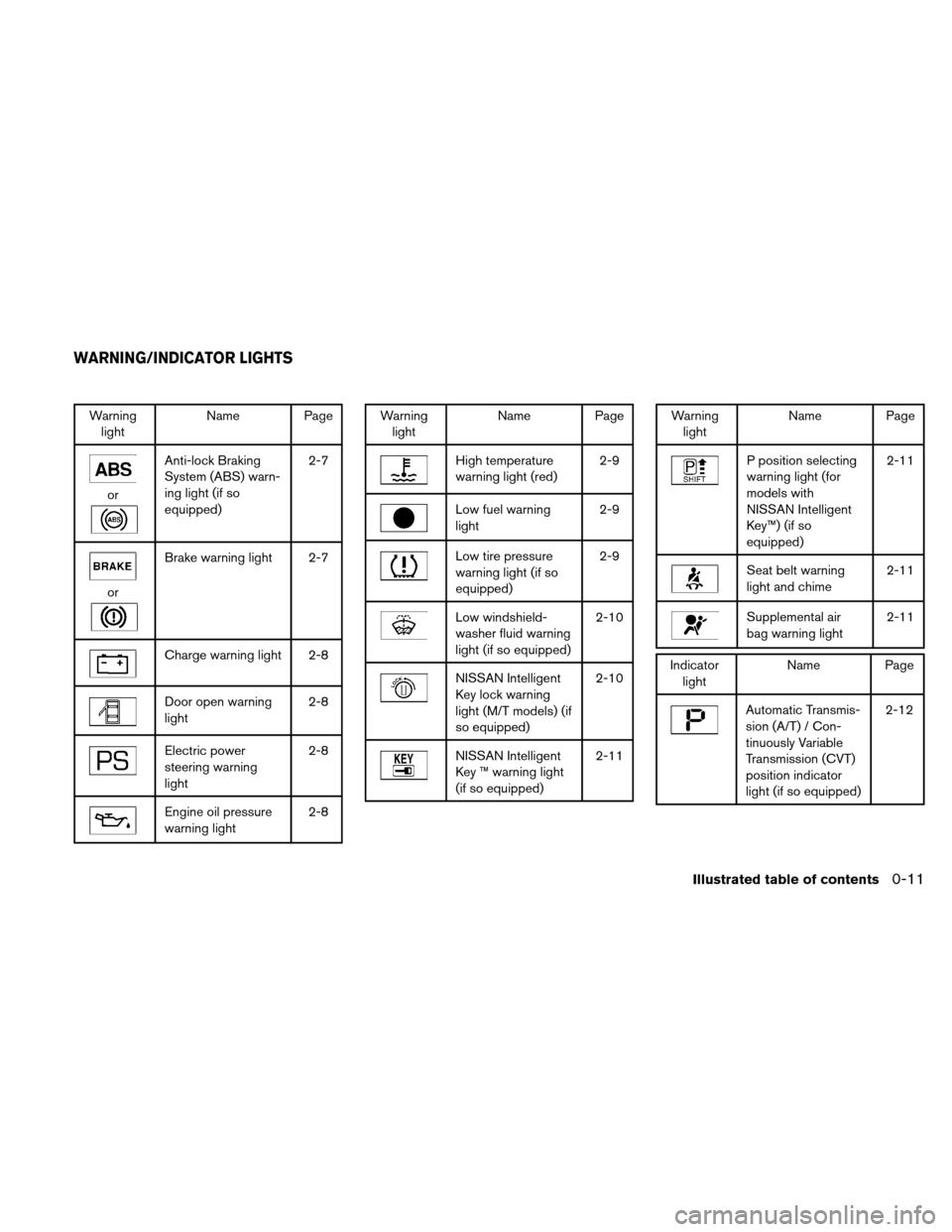
Warninglight Name Page
or
Anti-lock Braking
System (ABS) warn-
ing light (if so
equipped) 2-7
or
Brake warning light 2-7
Charge warning light 2-8
Door open warning
light
2-8
Electric power
steering warning
light2-8
Engine oil pressure
warning light
2-8
Warning
light Name Page
High temperature
warning light (red) 2-9
Low fuel warning
light2-9
Low tire pressure
warning light (if so
equipped)2-9
Low windshield-
washer fluid warning
light (if so equipped)2-10
NISSAN Intelligent
Key lock warning
light (M/T models) (if
so equipped)2-10
NISSAN Intelligent
Key ™ warning light
(if so equipped)
2-11
Warning
light Name Page
P position selecting
warning light (for
models with
NISSAN Intelligent
Key™) (if so
equipped) 2-11
Seat belt warning
light and chime
2-11
Supplemental air
bag warning light2-11
Indicator
light Name Page
Automatic Transmis-
sion (A/T) / Con-
tinuously Variable
Transmission (CVT)
position indicator
light (if so equipped) 2-12
WARNING/INDICATOR LIGHTS
Illustrated table of contents0-11
Page 83 of 338
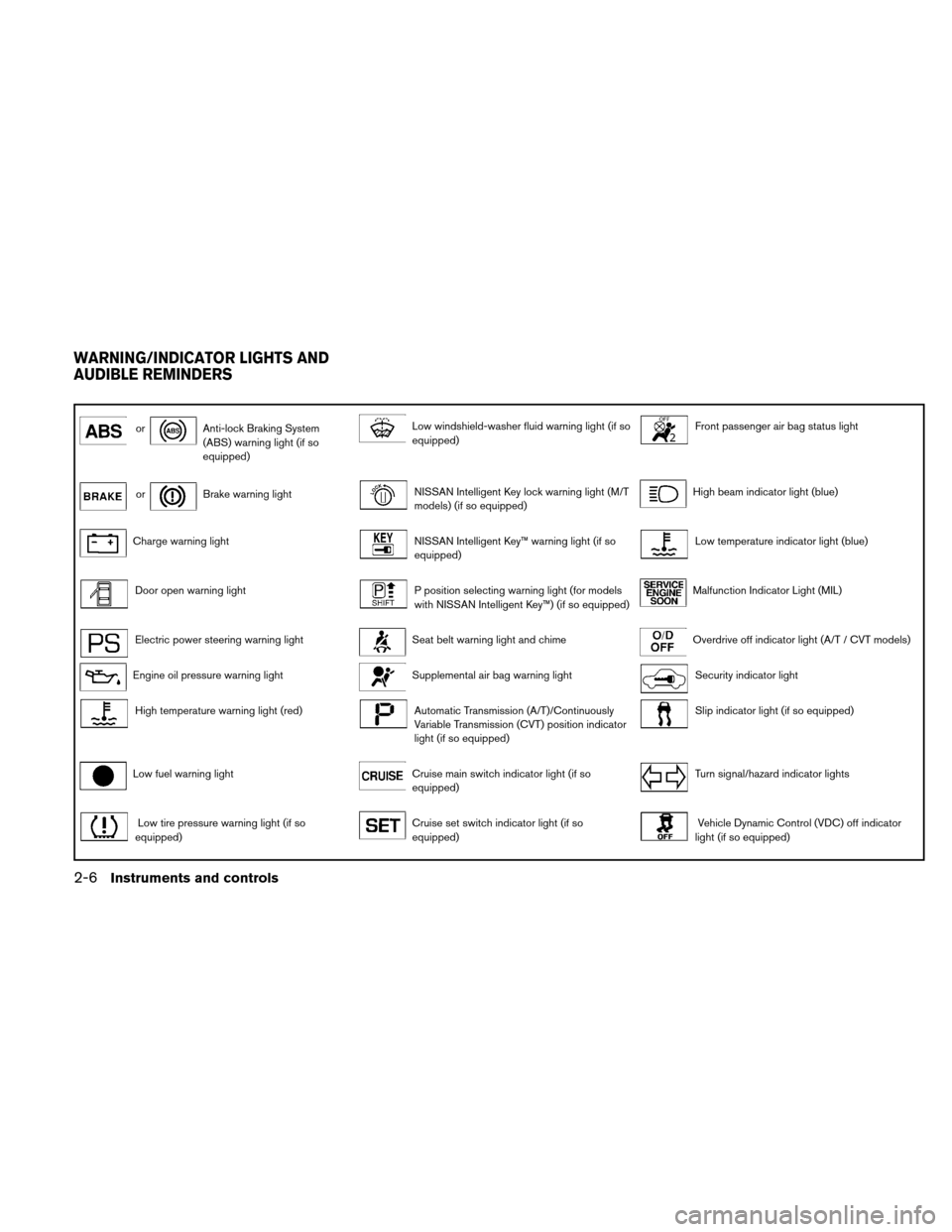
orAnti-lock Braking System
(ABS) warning light (if so
equipped)Low windshield-washer fluid warning light (if so
equipped)Front passenger air bag status light
orBrake warning lightNISSAN Intelligent Key lock warning light (M/T
models) (if so equipped)High beam indicator light (blue)
Charge warning lightNISSAN Intelligent Key™ warning light (if so
equipped)Low temperature indicator light (blue)
Door open warning lightP position selecting warning light (for models
with NISSAN Intelligent Key™) (if so equipped)Malfunction Indicator Light (MIL)
Electric power steering warning lightSeat belt warning light and chimeOverdrive off indicator light (A/T / CVT models)
Engine oil pressure warning lightSupplemental air bag warning lightSecurity indicator light
High temperature warning light (red)Automatic Transmission (A/T)/Continuously
Variable Transmission (CVT) position indicator
light (if so equipped)Slip indicator light (if so equipped)
Low fuel warning lightCruise main switch indicator light (if so
equipped)Turn signal/hazard indicator lights
Low tire pressure warning light (if so
equipped)Cruise set switch indicator light (if so
equipped)Vehicle Dynamic Control (VDC) off indicator
light (if so equipped)
WARNING/INDICATOR LIGHTS AND
AUDIBLE REMINDERS
2-6Instruments and controls
Page 85 of 338
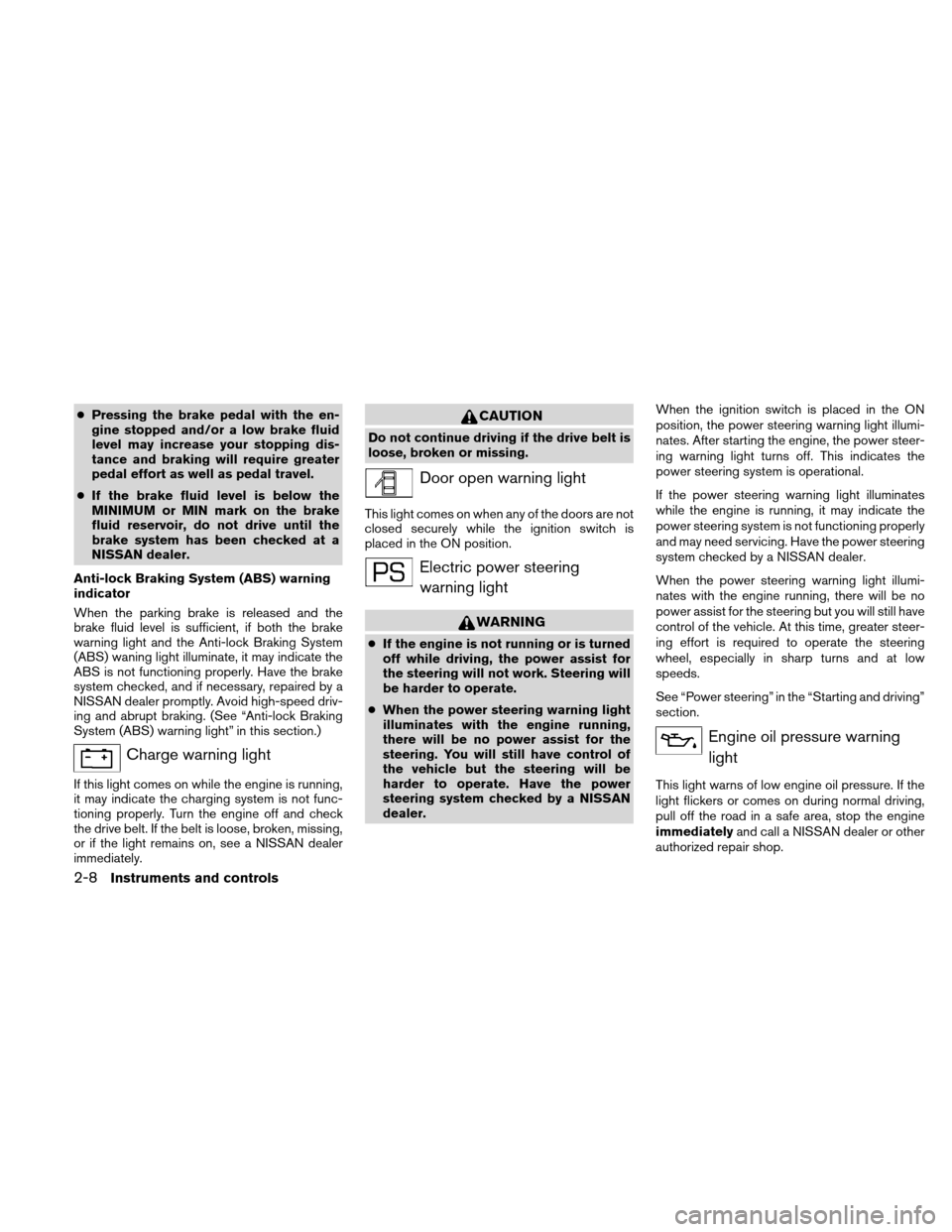
●Pressing the brake pedal with the en-
gine stopped and/or a low brake fluid
level may increase your stopping dis-
tance and braking will require greater
pedal effort as well as pedal travel.
● If the brake fluid level is below the
MINIMUM or MIN mark on the brake
fluid reservoir, do not drive until the
brake system has been checked at a
NISSAN dealer.
Anti-lock Braking System (ABS) warning
indicator
When the parking brake is released and the
brake fluid level is sufficient, if both the brake
warning light and the Anti-lock Braking System
(ABS) waning light illuminate, it may indicate the
ABS is not functioning properly. Have the brake
system checked, and if necessary, repaired by a
NISSAN dealer promptly. Avoid high-speed driv-
ing and abrupt braking. (See “Anti-lock Braking
System (ABS) warning light” in this section.)
Charge warning light
If this light comes on while the engine is running,
it may indicate the charging system is not func-
tioning properly. Turn the engine off and check
the drive belt. If the belt is loose, broken, missing,
or if the light remains on, see a NISSAN dealer
immediately.
CAUTION
Do not continue driving if the drive belt is
loose, broken or missing.
Door open warning light
This light comes on when any of the doors are not
closed securely while the ignition switch is
placed in the ON position.
Electric power steering warning light
WARNING
● If the engine is not running or is turned
off while driving, the power assist for
the steering will not work. Steering will
be harder to operate.
● When the power steering warning light
illuminates with the engine running,
there will be no power assist for the
steering. You will still have control of
the vehicle but the steering will be
harder to operate. Have the power
steering system checked by a NISSAN
dealer. When the ignition switch is placed in the ON
position, the power steering warning light illumi-
nates. After starting the engine, the power steer-
ing warning light turns off. This indicates the
power steering system is operational.
If the power steering warning light illuminates
while the engine is running, it may indicate the
power steering system is not functioning properly
and may need servicing. Have the power steering
system checked by a NISSAN dealer.
When the power steering warning light illumi-
nates with the engine running, there will be no
power assist for the steering but you will still have
control of the vehicle. At this time, greater steer-
ing effort is required to operate the steering
wheel, especially in sharp turns and at low
speeds.
See “Power steering” in the “Starting and driving”
section.
Engine oil pressure warning
light
This light warns of low engine oil pressure. If the
light flickers or comes on during normal driving,
pull off the road in a safe area, stop the engine
immediately and call a NISSAN dealer or other
authorized repair shop.
2-8Instruments and controls
Page 116 of 338
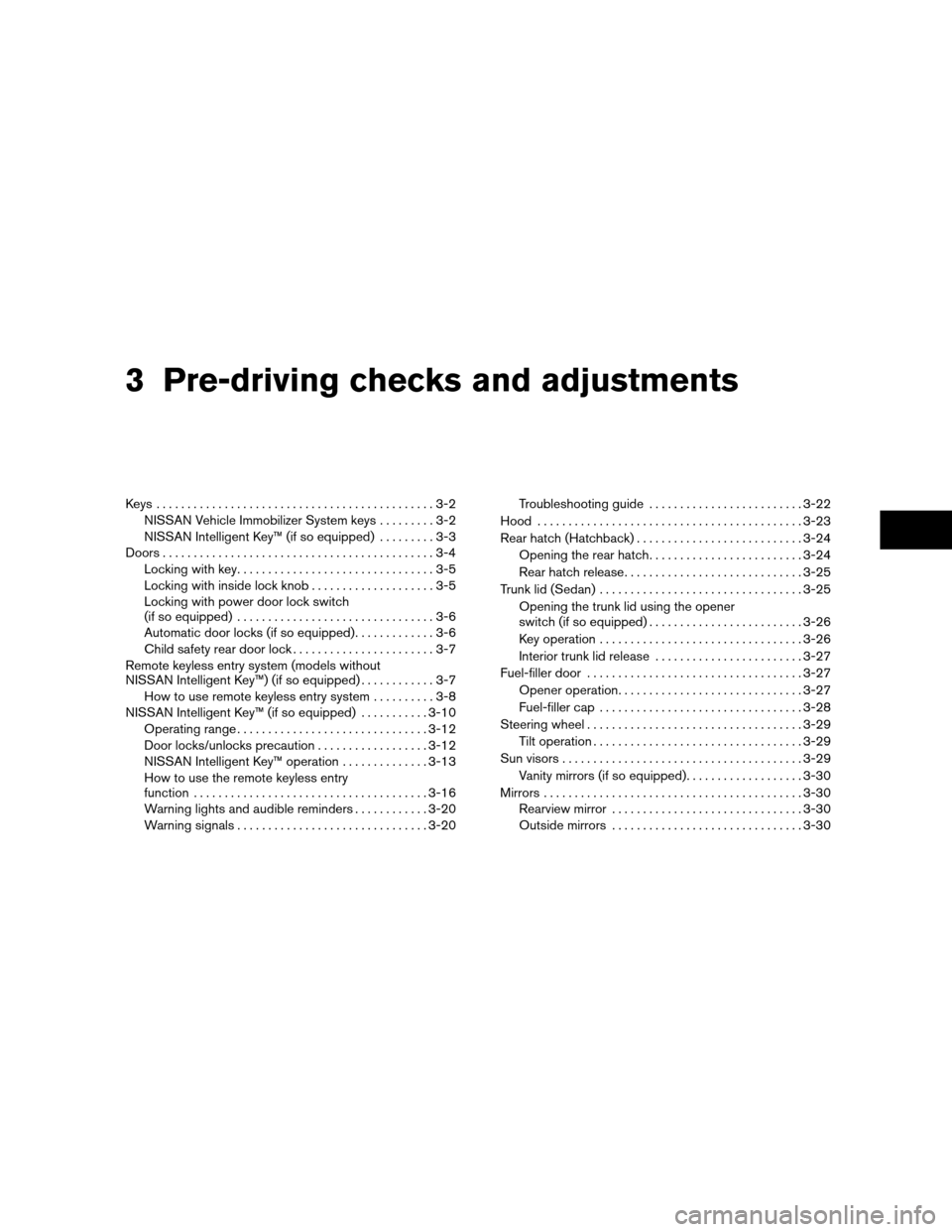
3 Pre-driving checks and adjustments
Keys .............................................3-2NISSAN Vehicle Immobilizer System keys .........3-2
NISSAN Intelligent Key™ (if so equipped) .........3-3
Doors ............................................3-4
Locking with key ................................3-5
Locking with inside lock knob . ...................3-5
Locking with power door lock switch
(if so equipped) ................................3-6
Automatic door locks (if so equipped) .............3-6
Child safety rear door lock .......................3-7
Remote keyless entry system (models without
NISSAN Intelligent Key™) (if so equipped) ............3-7
How to use remote keyless entry system ..........3-8
NISSAN Intelligent Key™ (if so equipped) ...........3-10
Operating range ............................... 3-12
Door locks/unlocks precaution ..................3-12
NISSAN Intelligent Key™ operation ..............3-13
How to use the remote keyless entry
function ...................................... 3-16
Warning lights and audible reminders ............3-20
Warning signals ............................... 3-20Troubleshooting guide
......................... 3-22
Hood ........................................... 3-23
Rear hatch (Hatchback) ........................... 3-24
Opening the rear hatch ......................... 3-24
Rear hatch release ............................. 3-25
Trunk lid (Sedan) ................................. 3-25
Opening the trunk lid using the opener
switch (if so equipped) ......................... 3-26
Key operation ................................. 3-26
Interior trunk lid release ........................ 3-27
Fuel-filler door ................................... 3-27
Opener operation .............................. 3-27
Fuel-filler cap ................................. 3-28
Steering wheel ................................... 3-29
Tilt operation .................................. 3-29
Sun visors ....................................... 3-29
Vanity mirrors (if so equipped) ...................3-30
Mirrors .......................................... 3-30
Rearview mirror ............................... 3-30
Outside mirrors ............................... 3-30
Page 192 of 338
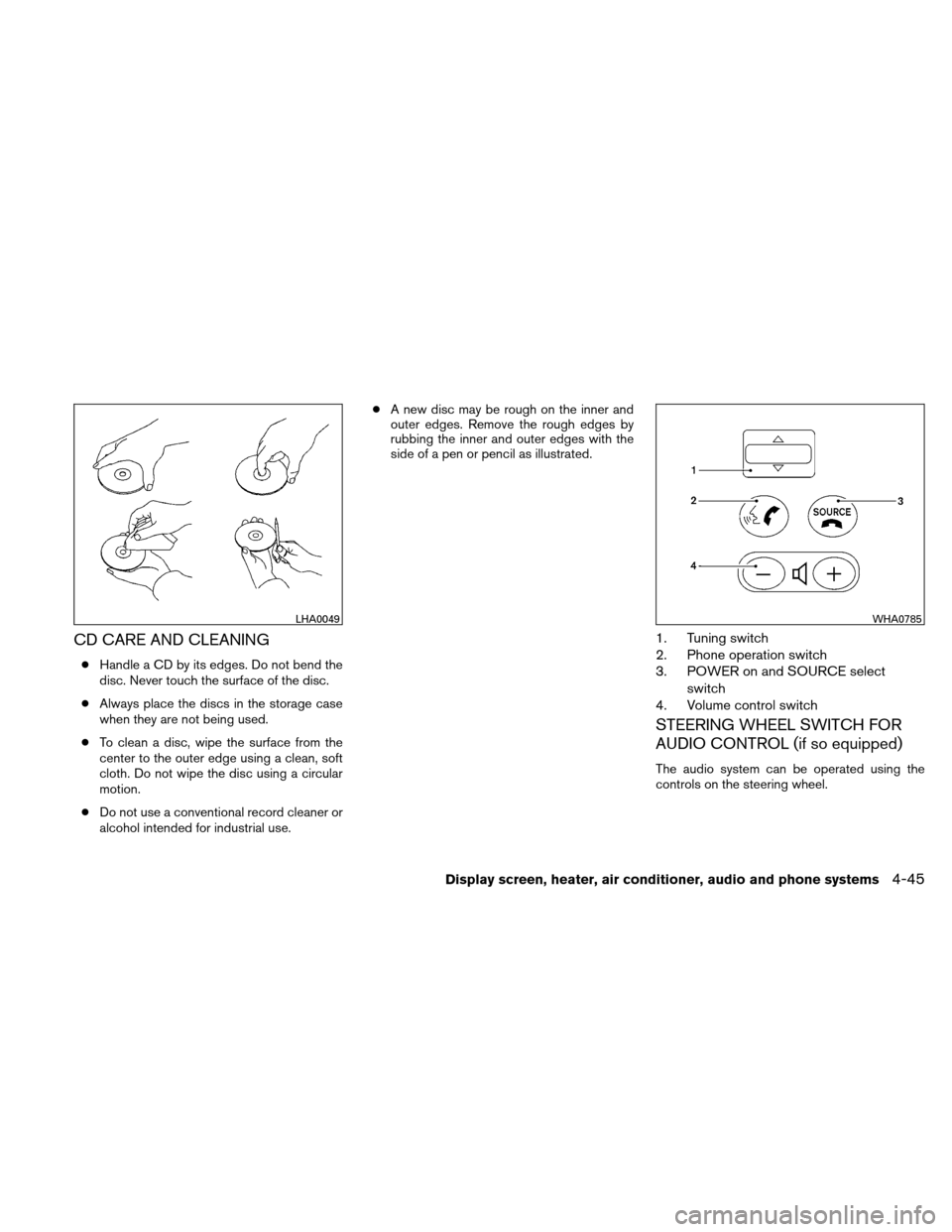
CD CARE AND CLEANING
●Handle a CD by its edges. Do not bend the
disc. Never touch the surface of the disc.
● Always place the discs in the storage case
when they are not being used.
● To clean a disc, wipe the surface from the
center to the outer edge using a clean, soft
cloth. Do not wipe the disc using a circular
motion.
● Do not use a conventional record cleaner or
alcohol intended for industrial use. ●
A new disc may be rough on the inner and
outer edges. Remove the rough edges by
rubbing the inner and outer edges with the
side of a pen or pencil as illustrated.
1. Tuning switch
2. Phone operation switch
3. POWER on and SOURCE select
switch
4. Volume control switch
STEERING WHEEL SWITCH FOR
AUDIO CONTROL (if so equipped)
The audio system can be operated using the
controls on the steering wheel.
LHA0049WHA0785
Display screen, heater, air conditioner, audio and phone systems4-45
Page 210 of 338
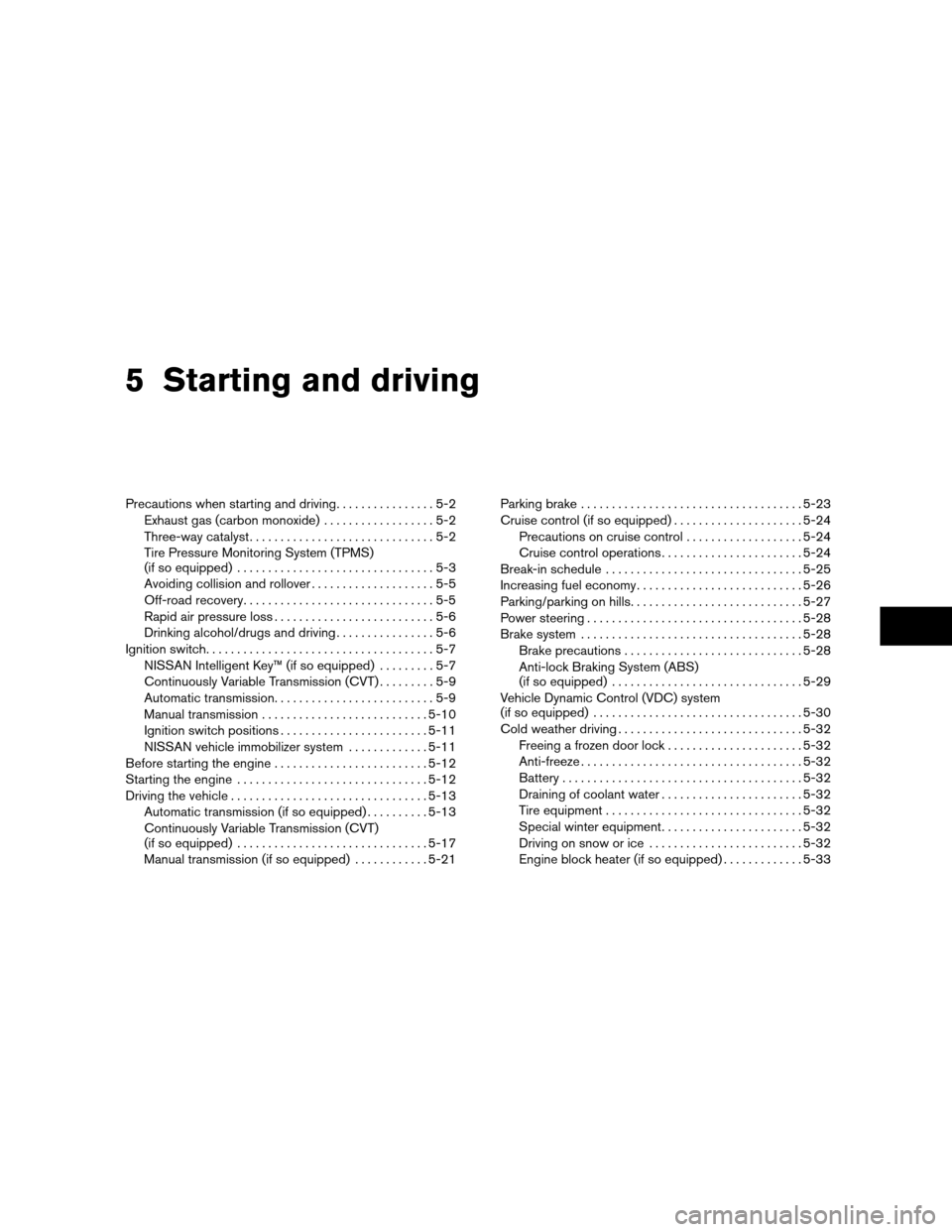
5 Starting and driving
Precautions when starting and driving................5-2
Exhaust gas (carbon monoxide) ..................5-2
Three-way catalyst ..............................5-2
Tire Pressure Monitoring System (TPMS)
(if so equipped) ................................5-3
Avoiding collision and rollover ....................5-5
Off-road recovery ...............................5-5
Rapid air pressure loss ..........................5-6
Drinking alcohol/drugs and driving ................5-6
Ignition switch .....................................5-7
NISSAN Intelligent Key™ (if so equipped) .........5-7
Continuously Variable Transmission (CVT) .........5-9
Automatic transmission ..........................5-9
Manual transmission ........................... 5-10
Ignition switch positions ........................ 5-11
NISSAN vehicle immobilizer system .............5-11
Before starting the engine ......................... 5-12
Starting the engine ............................... 5-12
Driving the vehicle ................................ 5-13
Automatic transmission (if so equipped) ..........5-13
Continuously Variable Transmission (CVT)
(if so equipped) ............................... 5-17
Manual transmission (if so equipped) ............5-21Parking brake
.................................... 5-23
Cruise control (if so equipped) .....................5-24
Precautions on cruise control ...................5-24
Cruise control operations .......................5-24
Break-in schedule ................................ 5-25
Increasing fuel economy ........................... 5-26
Parking/parking on hills ............................ 5-27
Power steering ................................... 5-28
Brake system .................................... 5-28
Brake precautions ............................. 5-28
Anti-lock Braking System (ABS)
(if so equipped) ............................... 5-29
Vehicle Dynamic Control (VDC) system
(if so equipped) .................................. 5-30
Cold weather driving .............................. 5-32
Freeing a frozen door lock ......................5-32
Anti-freeze .................................... 5-32
Battery ....................................... 5-32
Draining ofcoolant
water....................... 5-32
Tire equipment ................................ 5-32
Special winter equipment .......................5-32
Driving on snow or ice ......................... 5-32
Engine block heater (if so equipped) .............5-33
Page 237 of 338
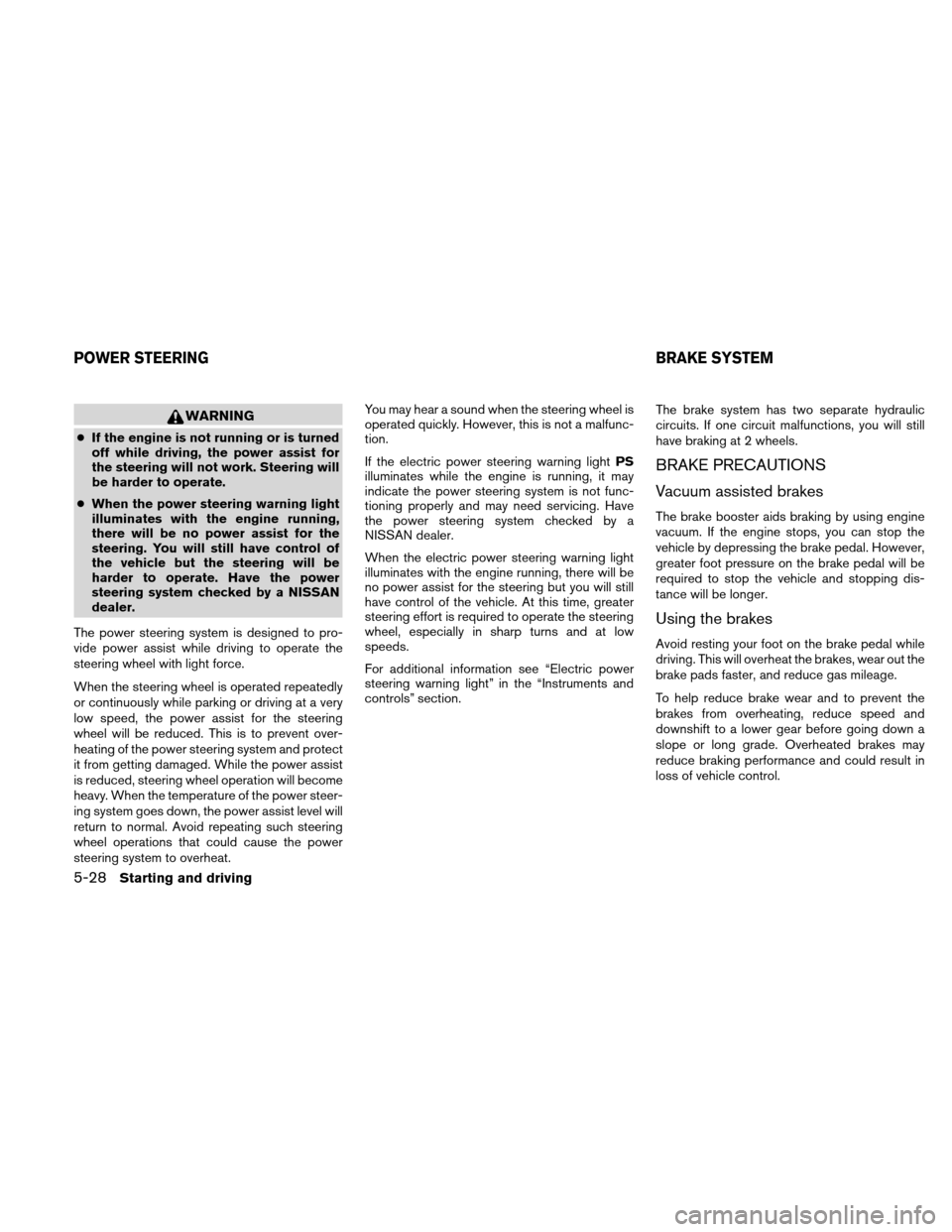
WARNING
●If the engine is not running or is turned
off while driving, the power assist for
the steering will not work. Steering will
be harder to operate.
● When the power steering warning light
illuminates with the engine running,
there will be no power assist for the
steering. You will still have control of
the vehicle but the steering will be
harder to operate. Have the power
steering system checked by a NISSAN
dealer.
The power steering system is designed to pro-
vide power assist while driving to operate the
steering wheel with light force.
When the steering wheel is operated repeatedly
or continuously while parking or driving at a very
low speed, the power assist for the steering
wheel will be reduced. This is to prevent over-
heating of the power steering system and protect
it from getting damaged. While the power assist
is reduced, steering wheel operation will become
heavy. When the temperature of the power steer-
ing system goes down, the power assist level will
return to normal. Avoid repeating such steering
wheel operations that could cause the power
steering system to overheat. You may hear a sound when the steering wheel is
operated quickly. However, this is not a malfunc-
tion.
If the electric power steering warning light
PS
illuminates while the engine is running, it may
indicate the power steering system is not func-
tioning properly and may need servicing. Have
the power steering system checked by a
NISSAN dealer.
When the electric power steering warning light
illuminates with the engine running, there will be
no power assist for the steering but you will still
have control of the vehicle. At this time, greater
steering effort is required to operate the steering
wheel, especially in sharp turns and at low
speeds.
For additional information see “Electric power
steering warning light” in the “Instruments and
controls” section. The brake system has two separate hydraulic
circuits. If one circuit malfunctions, you will still
have braking at 2 wheels.
BRAKE PRECAUTIONS
Vacuum assisted brakes
The brake booster aids braking by using engine
vacuum. If the engine stops, you can stop the
vehicle by depressing the brake pedal. However,
greater foot pressure on the brake pedal will be
required to stop the vehicle and stopping dis-
tance will be longer.
Using the brakes
Avoid resting your foot on the brake pedal while
driving. This will overheat the brakes, wear out the
brake pads faster, and reduce gas mileage.
To help reduce brake wear and to prevent the
brakes from overheating, reduce speed and
downshift to a lower gear before going down a
slope or long grade. Overheated brakes may
reduce braking performance and could result in
loss of vehicle control.
POWER STEERING
BRAKE SYSTEM
5-28Starting and driving
Page 238 of 338
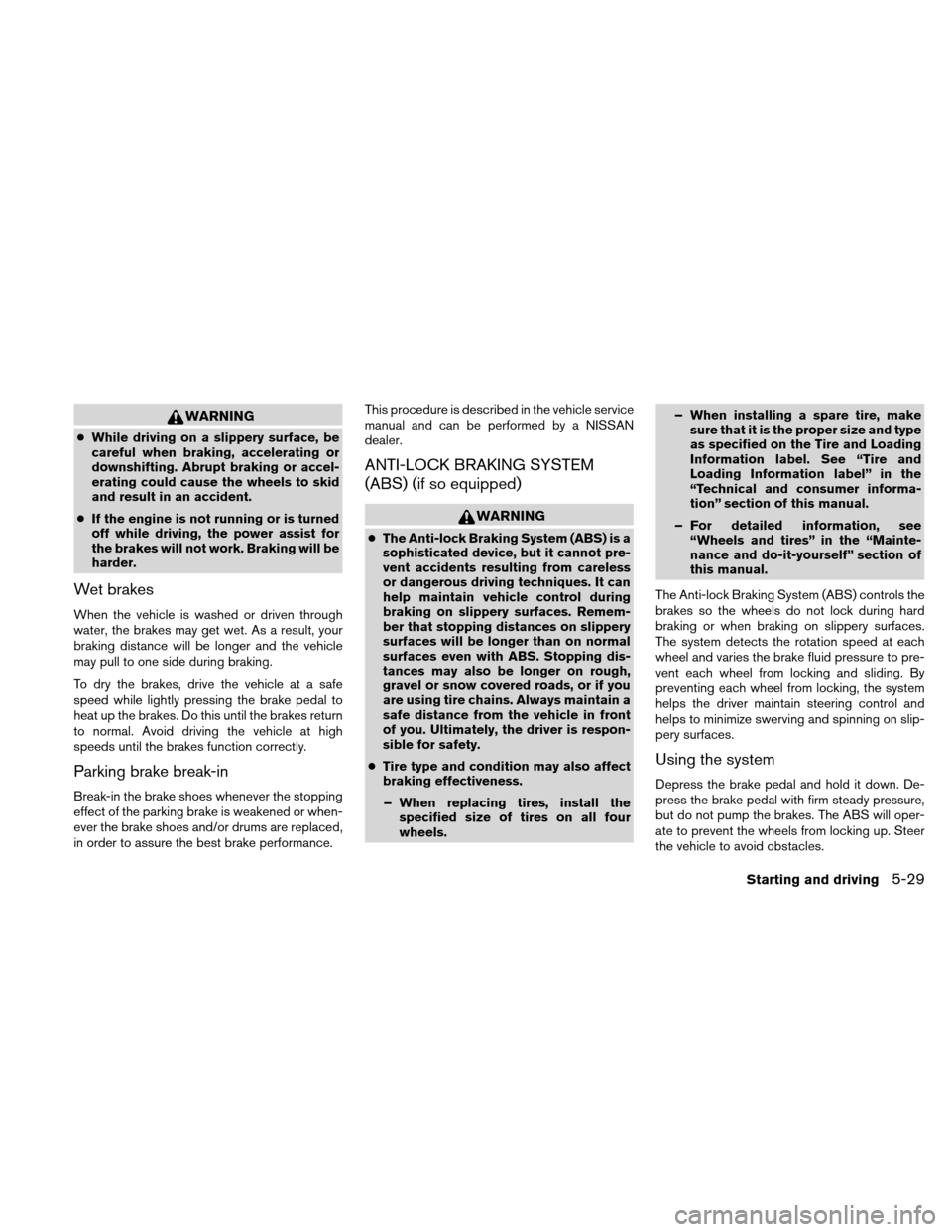
WARNING
●While driving on a slippery surface, be
careful when braking, accelerating or
downshifting. Abrupt braking or accel-
erating could cause the wheels to skid
and result in an accident.
● If the engine is not running or is turned
off while driving, the power assist for
the brakes will not work. Braking will be
harder.
Wet brakes
When the vehicle is washed or driven through
water, the brakes may get wet. As a result, your
braking distance will be longer and the vehicle
may pull to one side during braking.
To dry the brakes, drive the vehicle at a safe
speed while lightly pressing the brake pedal to
heat up the brakes. Do this until the brakes return
to normal. Avoid driving the vehicle at high
speeds until the brakes function correctly.
Parking brake break-in
Break-in the brake shoes whenever the stopping
effect of the parking brake is weakened or when-
ever the brake shoes and/or drums are replaced,
in order to assure the best brake performance. This procedure is described in the vehicle service
manual and can be performed by a NISSAN
dealer.
ANTI-LOCK BRAKING SYSTEM
(ABS) (if so equipped)
WARNING
●
The Anti-lock Braking System (ABS) is a
sophisticated device, but it cannot pre-
vent accidents resulting from careless
or dangerous driving techniques. It can
help maintain vehicle control during
braking on slippery surfaces. Remem-
ber that stopping distances on slippery
surfaces will be longer than on normal
surfaces even with ABS. Stopping dis-
tances may also be longer on rough,
gravel or snow covered roads, or if you
are using tire chains. Always maintain a
safe distance from the vehicle in front
of you. Ultimately, the driver is respon-
sible for safety.
● Tire type and condition may also affect
braking effectiveness.
– When replacing tires, install the specified size of tires on all four
wheels. – When installing a spare tire, make
sure that it is the proper size and type
as specified on the Tire and Loading
Information label. See “Tire and
Loading Information label” in the
“Technical and consumer informa-
tion” section of this manual.
– For detailed information, see “Wheels and tires” in the “Mainte-
nance and do-it-yourself” section of
this manual.
The Anti-lock Braking System (ABS) controls the
brakes so the wheels do not lock during hard
braking or when braking on slippery surfaces.
The system detects the rotation speed at each
wheel and varies the brake fluid pressure to pre-
vent each wheel from locking and sliding. By
preventing each wheel from locking, the system
helps the driver maintain steering control and
helps to minimize swerving and spinning on slip-
pery surfaces.
Using the system
Depress the brake pedal and hold it down. De-
press the brake pedal with firm steady pressure,
but do not pump the brakes. The ABS will oper-
ate to prevent the wheels from locking up. Steer
the vehicle to avoid obstacles.
Starting and driving5-29